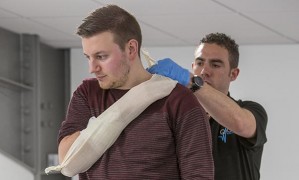This accredited qualification is ideal for those already working or preparing to work within industry wishing to become a First Aider in the workplace for the purposes of the Health and Safety (First Aid) Regulations 1981 and the Health and Safety (First Aid) Regulations (NI) 1982.
The recommended course duration is 3 days and topics covered include: the roles and responsibilities of the First Aider; assessing an incident, recognising signs and symptoms of injury and illness, assisting a casualty who is suffering from major injury and illness, chest injuries, spinal injuries and anaphylaxis. The qualification is assessed via on-going oral and/or written questioning and practical demonstration.
Course Curriculum:
Unit 1:
Emergency First Aid in the Workplace (credit can be given in some cases if already completed recently)
- Understand the role and responsibilities of a first aider
- (Identify the role and responsibilities of a first aider, Describe how to minimise the risk of infection to self and others, Identify the need for establishing consent to provide first aid, Complete an accident report form, Identify the first aid equipment that should be available in a workplace, Describe the safe use of first aid equipment)
- Be able to assess an incident
- (Conduct a scene survey, Conduct a primary survey of a casualty, Give examples of when to call for help)
- Be able to manage an unresponsive casualty who is breathing normally
- (Assess a casualty’s level of consciousness, Open a casualty’s airway and check breathing, Explain why it is important to place an unconscious casualty into the recovery position, Place an unresponsive casualty in the recovery position, Manage a casualty who is in seizure)
- Be able to manage an unresponsive casualty who is not breathing normally,
- (Recognise the need to commence Cardio Pulmonary Resuscitation, Demonstrate Cardio Pulmonary Resuscitation using a manikin)
- Be able to recognise and assist a casualty who is choking
- (Describe how to identify a casualty with a Partially blocked airway, Describe how to identify a casualty with a completely blocked airway, Administer first aid to a casualty who is choking)
- Be able to manage a casualty with external bleeding
- (Identify the types of external bleeding, Control external bleeding)
- Be able to manage a casualty who is in shock
- (Recognise shock. Administer first aid to a casualty who is in shock)
- Be able to manage a casualty with a minor injury
- (Administer first aid to a casualty with small cuts, grazes and bruises. Administer first aid to a casualty with minor burns and scalds, Administer first aid to a casualty with small splinters)
Unit 2:
Recognition and Management of Illness and Injury in the Workplace
- Be able to conduct a secondary survey
- (Identify the information to be collected when gathering a casualty history, Conduct a head to toe survey)
- Be able to administer first aid to a casualty with injuries to bones, muscles and joints
- (Recognise suspected; Fractures, Dislocations, Sprains and strains, Administer first aid for; Fractures, Dislocations, Sprains and strains)
- Be able to administer First Aid to a casualty with suspected head and spinal injuries
- (Recognise suspected; Concussion, Skull fracture, Cerebral compression, Spinal injury, Administer first aid for suspected; Concussion, Skull Fracture, Cerebral compression, Spinal injury)
- Be able to administer First Aid to a casualty with suspected chest injuries
- (Recognise the different types of chest injury, Administer first aid for a chest injury)
- Be able to administer First Aid to a casualty with burns and scalds
- (Recognise the factors that affect the severity of burns and scalds, Administer first aid for burns involving; Dry heat, Wet heat, Electricity and Chemicals)
- Be able to administer First Aid to a casualty with an eye injury
- (Give examples of common eye injuries, Administer first aid for eye injuries involving; Dust, Chemicals and Embedded objects)
- Be able to administer First Aid to a casualty with sudden poisoning
- (Identify the routes that poisons can take to enter the body, Administer immediate first aid to a casualty affected by sudden poisoning, Identify sources of information for treating those affected by sudden poisoning)
- Be able to administer First Aid to a casualty with anaphylaxis
- (Identify common triggers for anaphylaxis, Recognise anaphylaxis, Administer immediate first aid for a casualty suffering from anaphylaxis)
- Be able to provide First Aid to a casualty with suspected major illness
- (Recognise major illnesses including; Heart Attack, Stroke, Epilepsy, Asthma and Diabetes, Administer first aid to a casualty suffering from major illnesses including; Heart Attack, Stroke, Epilepsy, Asthma and Diabetes)
Course Duration:
This course has a guidance training time of 18 hours, this is completed over a three day period.
Certification:
Each student will gain a TQUK Level 3 Award in First Aid at Work (RQF) regulated qualification.
For more information or to book a course, please contact us here
-

Our Clinical Training provides up to date information for clinicians. This will provide continuing professional development (CPD) hours towards revalidation for nurses and midwives.
View courses
-

Our health & safety training courses provide the fundamentals any organisation or individual requires to be compliant with HSE guidelines, ranging from Manual Handling, Health & Safety, Fire Safety and Food Hygiene Training.
View courses
-

Our emergency care training includes Paediatric and Adult based courses. Whether you're a builder, childminder, carer or doctor it is essential you understand the basic skills required for potentially saving a life.
View courses


